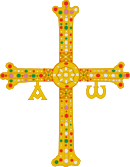- La Cava Bible
-
The La Cava Bible or Codex Cavensis (Cava de' Tirreni, Biblioteca della Badia, Ms. memb. I) is a 9th century Latin illuminated Bible, which was produced in Spain, probably in the Kingdom of Asturias during the reign of Alfonso II. The manuscript preserved at the abbey of La Trinità della Cava, near Cava de' Tirreni, contains 330 vellum folios which measure 320 by 260 mm.
Contents
Origin
The Bible was signed on folio 166v by a scribe named Danila. The location of the scriptorium in which Danila worked is not known. However the hand, textual variations, and orthography indicate that the manuscript was produced in Spain, during the early 9th century. It is unlikely that such a luxury manuscript could have been produced in the Muslim-controlled areas of the Iberian Peninsula. This makes Asturias, which was the largest Christian kingdom of the time, the most probable source for codex. Additional evidence of an Asturian origin is provided by the decoration of the manuscript. The Cross which appears in four locations in the La Cava Bible, is the only explicitly Christian decoration in the manuscript. Although the form of the Crosses in the La Cava Bible do not appear in other surviving Asturian art, the Cross was emphasized in Asturian devotional art. For example, both Alfonso II and Alfonso III commissioned gold crosses, like the Victory Cross and the Cross of the Angels. "Cross of the Resurrection" was a prominent feature of murals at San Julián de los Prados, near Oviedo, Asturias.
Decoration
The decoration of the La Cava Bible is limited to the four crosses mentioned above, frames surrounding explicits and titles, and decorated initials. There are two linear, compass drawn Crosses, one serving as frontispiece on folio 1 verso, and the other in the introduction to the prophetical books on folio 143 recto. On folio 100 verso the title frame for the Psalms is in the form of a cross. The text on folio 220 verso, which contains the prefaces by Jerome used to introduce the New Testament, is written in the form of a cross. This text is written in red, white and yellow inks on a blue-stained folio. There is one other folio stained blue and three folios stained purple in this manuscript. The frames surrounding the explicits and titles are similar in form to frames found in the earliest medieval illuminated books. However, Danila exploited brilliant and contrasting hues of color not found in earlier manuscripts. The decorated initials include initial types commonly associated with Merovingian illumination. However similar initials also occurred in Visigothic manuscripts.
It is likely that Danila copied this manuscript from an earlier, now-lost, Visigothic manuscript. The title and explicit frames are similar to those found in early manuscripts and the pages written in colored inks are related to Late Antique manuscripts written in gold and silver on purple-dyed parchment. (For example, see Rossano Gospels). However Danila's use of color was probably not present in the original manuscript and anticipates the use of color in later Spanish manuscripts.
Although Danila may have been aware of Merovingian initials, it is also equally likely that his initials share in common the models for Merovingian initials. The manuscript gives no indication that Danila was influenced by contemporary Carolingian illumination. However, Carolingian Bibles produced under the patronage of Theodulph of Orleans, who had Visigothic parentage, do have similar text and organization to that found in the La Cava Bible, something not found in other similar Carolingian manuscripts.
Text
It is one of the two most important representatives of the Spanish type of Vulgate text. The text of the Gospels shows signs of being a revision, being mingled with Old Latin elements. It is the oldest biblical manuscript which contains the Comma Johanneum.[1]
See also
References
- ^ Bruce M. Metzger, The Early Versions of the New Testament (Oxford 1977, p. 338.)
Further reading
- Williams, John, Early Spanish Manuscript Illumination (New York: 1977).
External links
- Information about the name "La Cava"
- Specifications about the origin of the word and Bible
- Samuel Berger, Histoire de la Vulgate pendant les premiers siècles du moyen âge (1976), pp. 12 ff
Pre-romanesque art in the Kingdom of Asturias Pre-Romanesque art in Asturias is framed between the years 711 and 925, the period of the rise and extension of the Kingdom of Asturias.Architecture 1st Period (737 to 791)Santa Cruz de Cangas de Onís • Church of San Juan Apóstol y Evangelista2nd Period (791 to 842)3rd period (842 to 866)Church of Santa María del Naranco • Church of San Miguel de Lillo • Church of Santa Cristina de Lena4th period (866 to 910)5th period (910 to 925)
Infrastructure La FoncaladaMajor figures Minor arts Spiritual legacy Way of St. James • Codex CavensisCategories:- Illuminated biblical manuscripts
- Asturian culture
- History of Asturias
- Vulgate manuscripts
- 9th-century biblical manuscripts
- Mozarabic art
Wikimedia Foundation. 2010.


